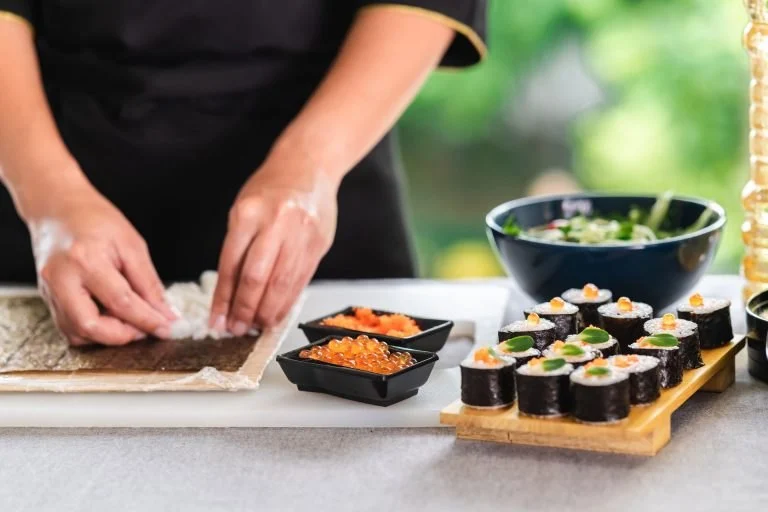
- 1. The Rise of Sustainable Sushi
- 2. What Makes Sushi Ingredients Responsible and Sustainable
- 3. Sushi Restaurants Committing to Ethical Practices
- 4. How Consumers Are Influencing Sustainable Sushi
- 5. Real-World Examples of Sustainable Sushi Restaurants
1. The Rise of Sustainable Sushi
Sushi has long been a beloved dish worldwide, but in recent years, a growing awareness of environmental issues has led to a significant shift in how sushi is prepared and served. Today, more and more sushi restaurants are focusing on sourcing their ingredients responsibly and sustainably, recognizing the importance of protecting the oceans and marine life. This movement is part of a larger global trend toward ethical dining, where consumers are becoming more mindful of where their food comes from and the environmental impact it has.
Sustainability in the sushi industry involves careful attention to sourcing ingredients that are both environmentally friendly and ethically produced. From sustainable seafood to locally grown vegetables, these restaurants are making a concerted effort to ensure their food is not only delicious but also responsible. As awareness continues to grow, consumers can make informed choices about where to dine and support establishments that prioritize eco-conscious practices.

Forsyth Fire Escape / forsyth fire escape
New YorkNew York CountyNew York
601 W 26th St, New York, NY 10001, USA
2. What Makes Sushi Ingredients Responsible and Sustainable
To truly understand the concept of sustainable sushi, it's essential to look at what makes an ingredient responsible and sustainable. These are the key factors that contribute to the eco-friendly practices of sushi restaurants:
1. Sourcing Seafood Responsibly
One of the primary concerns in sushi sustainability is the sourcing of seafood. Overfishing is a major issue, threatening many fish species with extinction. Responsible sushi restaurants prioritize seafood that is sustainably sourced, such as fish caught in well-managed fisheries or farmed in eco-friendly aquaculture systems. Organizations like the Marine Stewardship Council (MSC) help guide consumers and restaurants by certifying sustainable seafood options.
2. Avoiding Endangered Species
Another key aspect of sustainable sushi is avoiding the use of endangered species, such as bluefin tuna, which is often caught using harmful methods. Instead, ethical sushi restaurants offer alternatives like farmed tuna or other species that are abundant and caught in a sustainable manner. This helps protect marine biodiversity while still providing a high-quality dining experience.
3. Supporting Local and Organic Ingredients
In addition to sustainable seafood, many sushi restaurants are also turning to local and organic ingredients. From rice and vegetables to seaweed, sourcing local produce reduces the carbon footprint associated with transportation and supports local farmers. Organic practices also help protect the land and water used for farming, reducing exposure to harmful pesticides and chemicals.
3. Sushi Restaurants Committing to Ethical Practices
As sustainability becomes more of a priority for diners, sushi restaurants across the globe are committing to ethical sourcing practices. These establishments are not only improving the sustainability of their ingredients but also adopting eco-friendly restaurant operations.
1. Waste Reduction and Sustainable Packaging
Sustainable sushi restaurants are increasingly focusing on reducing food waste and using sustainable packaging. For example, many restaurants are eliminating plastic straws and single-use plastics in favor of eco-friendly alternatives. Some also implement waste-reduction strategies in the kitchen, such as composting food scraps or using every part of the fish to minimize waste.
2. Energy and Water Conservation
Energy and water conservation are other important aspects of ethical sushi dining. Restaurants that prioritize sustainability often invest in energy-efficient equipment, such as LED lighting and energy-efficient kitchen appliances. Additionally, they take steps to reduce water usage in preparation and cleaning processes, contributing to overall environmental conservation.
3. Transparent Sourcing and Education
Transparency is a key component of sustainability. Many sushi restaurants are now providing detailed information about the sourcing of their ingredients, allowing customers to understand the environmental impact of their food choices. These establishments may also engage in educating their customers about sustainability, both in terms of the food they serve and broader environmental issues.
4. How Consumers Are Influencing Sustainable Sushi
Consumers play a significant role in driving the shift toward sustainable sushi. As more diners become aware of the environmental impact of their food choices, there is a growing demand for sushi restaurants that prioritize sustainability. This demand encourages restaurants to reevaluate their sourcing practices and adopt more eco-friendly options.
1. Increased Awareness and Demand
With documentaries, news coverage, and social media shedding light on overfishing, climate change, and the importance of responsible food sourcing, consumers are becoming more conscientious about the food they consume. This shift in consumer attitudes is directly influencing the food service industry, as restaurants respond to the call for sustainability by adjusting their menus and practices.
2. Supporting Sustainable Brands
Many consumers now actively seek out restaurants that align with their values, particularly when it comes to sustainability. Sushi diners are increasingly choosing establishments that source their ingredients ethically, even if it means paying a bit more. By supporting sustainable sushi restaurants, consumers are not only enjoying quality food but also helping to promote more sustainable practices in the industry.
5. Real-World Examples of Sustainable Sushi Restaurants
Several sushi restaurants around the world are leading the way in responsible sourcing and sustainability. Here are a few notable examples:
1. Sushi Noz
Located in New York City, Sushi Noz is a high-end sushi restaurant that is committed to sustainable practices. The restaurant sources its seafood from trusted suppliers that follow responsible fishing practices. It also emphasizes the use of organic and locally sourced ingredients, making it a model for sustainable fine dining.
2. Narisawa
In Tokyo, Narisawa has earned a reputation for serving sustainable sushi with an emphasis on seasonal, organic, and wild-caught ingredients. The restaurant’s focus on sustainability extends beyond just food, as it also incorporates eco-friendly practices in its operations, such as reducing waste and energy consumption.
3. Blue Ribbon Sushi
Blue Ribbon Sushi, a popular chain with locations in New York and Las Vegas, is committed to serving sustainably sourced seafood. The restaurant works with suppliers who adhere to ethical fishing methods, ensuring that their seafood options are both high-quality and environmentally responsible.
At Dine Droop, we understand the importance of dining with a conscience. Explore our platform to find the best sustainable sushi restaurants, ingredients, and culinary products that align with your values. Whether you're a seasoned sushi lover or new to the world of sustainable dining, we’ve got the recommendations you need for an eco-friendly dining experience.








 Bilt Neighborhood Cafe4.0 (41 reviews)
Bilt Neighborhood Cafe4.0 (41 reviews) Ruma and Shanta4.0 (11 reviews)
Ruma and Shanta4.0 (11 reviews) Mr.Platter+ Truck ( PATERSON ) 100% HALAL4.0 (28 reviews)
Mr.Platter+ Truck ( PATERSON ) 100% HALAL4.0 (28 reviews) NAYA4.0 (33 reviews)
NAYA4.0 (33 reviews) Cold Stone Creamery4.0 (422 reviews)
Cold Stone Creamery4.0 (422 reviews) Mitchell Place Natural Food3.0 (12 reviews)
Mitchell Place Natural Food3.0 (12 reviews) Discover Unique Coffee Shops with Limited Edition Blends and Specialty Roasts
Discover Unique Coffee Shops with Limited Edition Blends and Specialty Roasts Exploring Breakfast Restaurants That Experiment With International Fusion Dishes
Exploring Breakfast Restaurants That Experiment With International Fusion Dishes How Seafood Restaurants Are Incorporating Sustainable Practices
How Seafood Restaurants Are Incorporating Sustainable Practices Artisan Dessert Shops with Unique Flavor Profiles
Artisan Dessert Shops with Unique Flavor Profiles How Breakfast Restaurants Are Innovating With Healthy Alternatives
How Breakfast Restaurants Are Innovating With Healthy Alternatives Exploring Middle Eastern Restaurants That Offer Interactive Dining Experiences
Exploring Middle Eastern Restaurants That Offer Interactive Dining Experiences